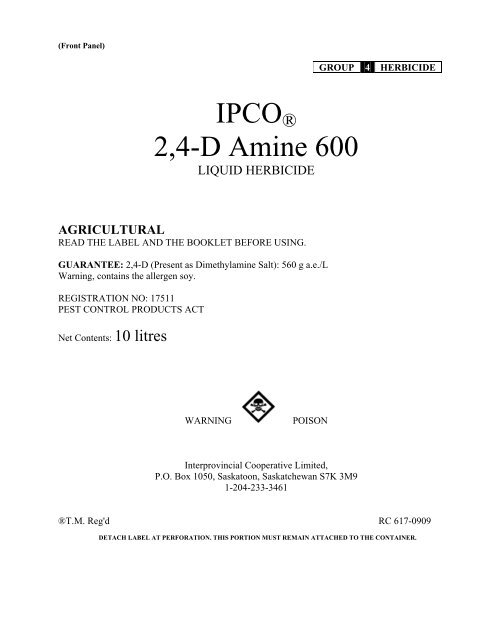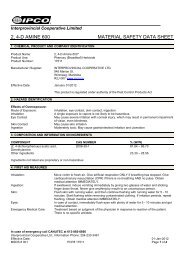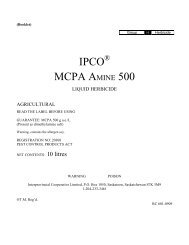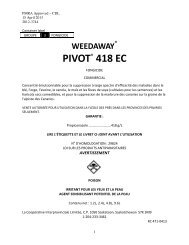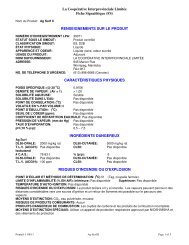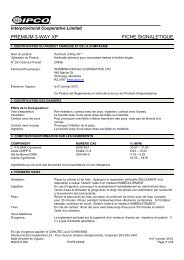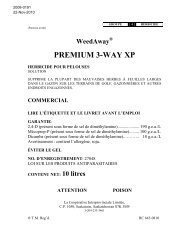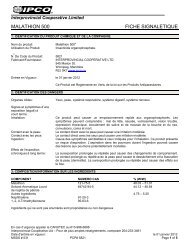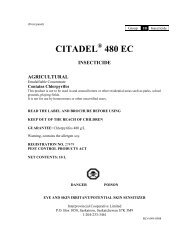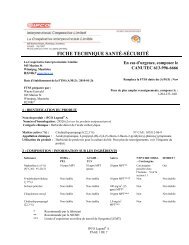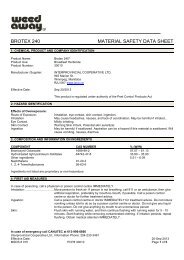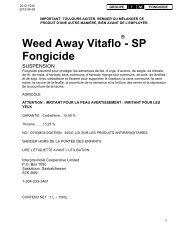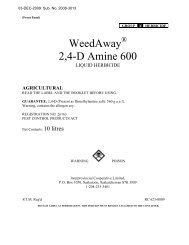IPCO® 2,4-D Amine 600
IPCO® 2,4-D Amine 600
IPCO® 2,4-D Amine 600
You also want an ePaper? Increase the reach of your titles
YUMPU automatically turns print PDFs into web optimized ePapers that Google loves.
(Front Panel)GROUP 4 HERBICIDEIPCO ®2,4-D <strong>Amine</strong> <strong>600</strong>LIQUID HERBICIDEAGRICULTURALREAD THE LABEL AND THE BOOKLET BEFORE USING.GUARANTEE: 2,4-D (Present as Dimethylamine Salt): 560 g a.e./LWarning, contains the allergen soy.REGISTRATION NO: 17511PEST CONTROL PRODUCTS ACTNet Contents: 10 litresWARNINGPOISONInterprovincial Cooperative Limited,P.O. Box 1050, Saskatoon, Saskatchewan S7K 3M91-204-233-3461®T.M. Reg'd RC 617-0909DETACH LABEL AT PERFORATION. THIS PORTION MUST REMAIN ATTACHED TO THE CONTAINER.
PRECAUTIONS: Handling precautions: KEEP OUT OF REACH OF CHILDREN. Avoid contact with eyes, skin andclothing. May cause skin irritation. Avoid inhaling vapours or mist. Protective Clothing and Equipment: Handling theconcentrate (mixing and loading): Wear coveralls over a long-sleeved shirt, long pants, chemical resistant gloves, socks andshoes. Rinse gloves before removal. Coveralls should be worn when pouring from containers. When handling more than 265kg a.e. (473 L of IPCO 2,4-D <strong>Amine</strong> <strong>600</strong> Liquid Herbicide) per day, workers must also used a closed system. Handling thedilute spray solution (during application or repairing or cleaning equipment): Wear coveralls over a long-sleeved shirt,long pants, chemical resistant gloves , socks and shoes. For aerial application no human flaggers are permitted. Rinse glovesbefore removal. Gloves are not required during application when applicator is in an enclosed tractor or an enclosed airplanecockpit. Operator use precautions: Wear freshly laundered clothing and clean protective equipment daily. Rinse gloves beforeremoval. Wash hands before eating, drinking, using tobacco or using the toilet. If herbicide penetrates clothing removeimmediately, then wash thoroughly and put on clean clothing. Throw away clothing and other absorbent materials that havebeen drenched or heavily contaminated with this product’s concentrate. After using this product, remove clothing and launderseparately and promptly, and thoroughly wash hands and exposed skin with soap and water. Follow manufacturer’s instructionsfor cleaning personal protective clothing and equipment. If no such instructions for washables are provided, use detergent andhot water. Keep and wash personal protective equipment separate from household laundry. After work, remove all clothing andshower using soap and water. GENERAL PRECAUTIONS: Handle with care and mix only in a closed container. Use only ina well ventilated area. May cause damage to susceptible crops, ornamentals and other plants, in minute quantities. Avoid drift todesirable vegetation. Do not spray during periods of high wind. Coarse sprays are less likely to drift. Do not contaminate anybody of water. Avoid contamination of foods. Keep in original container during storage. Do not re-use container unlessotherwise specified. Store the container tightly closed away from seeds, fertilizers, plants and foodstuffs. Store above 0 degreesC. SHAKE WELL BEFORE USING. Clean spray equipment thoroughly after use. If this pest control product is to be used on acommodity that may be exported to the U.S. and you require information on acceptable residue levels in the U.S., visit CropLifeCanada’s website at: www.croplife.ca. Re-Entry Interval: Do not enter treated areas within 12-hours after application.ENVIRONMENTAL PRECAUTIONS: Refer to the attached booklet for complete environmental hazards. FIRST AID: incase of poisoning, call a physician or poison control centre IMMEDIATELY. If on skin or clothing, take off contaminatedclothing. Rinse skin IMMEDIATELY with plenty of water for 15–20 minutes. Call a poison control centre or doctor fortreatment advice. If in eyes, hold eye open and rinse slowly and gently with water for 15–20 minutes. Remove contact lenses, ifpresent, after the first 5 minutes, then continue rinsing eye. Call a poison control centre or doctor for treatment advice. Ifswallowed, call a poison control centre or doctor IMMEDIATELY for treatment advice. Have person sip a glass of water if ableto swallow. Do not induce vomiting unless told to do so by a poison control centre or doctor. Do not give anything by mouth toan unconscious person. If inhaled, move person to fresh air. If person is not breathing, call 911 or an ambulance, then giveartificial respiration, preferably by mouth-to-mouth, if possible. Call a poison control centre or doctor for further treatmentadvice. Take the container, label, or product name and Pest Control Product registration number with you when seeking medicalattention. TOXICOLOGICAL INFORMATION: Treatment of any systemic intoxication should be primarily symptomaticand supportive. 2,4-D may cause severe irritation to the eyes. Overexposure to 2,4-D may cause coughing, burning, dizziness, ortemporary loss of muscle coordination. Other possible effects of overexposure include fatigue, muscle weakness and nausea.RINSING AND DISPOSAL INFORMATION: For Recyclable Containers: Do not reuse this container for any purpose. Thisis a recyclable container, and is to be disposed of at a container collection site. Contact your local distributor/dealer ormunicipality for the location of the nearest collection site. Before taking the container to the collection site: 1. Triple- orpressure-rinse the empty container. Add the rinsings to the spray mixture in the tank. 2. Make the empty, rinsed containerunsuitable for further use. If there is no container collection site in your area, dispose of the container in accordance withprovincial requirements. For Returnable Containers: Do not reuse this container for any purpose. For disposal, this emptycontainer may be returned to the point of purchase (distributor/dealer). For Returnable/Refillable Containers: For disposal,this container may be returned to the point of purchase (distributor/dealer). It must be refilled by the distributor/dealer with thesame product. Do not reuse this container for any other purpose. For information on disposal of unused, unwanted product,contact the manufacturer or the provincial regulatory agency. Contact the manufacturer and the provincial regulatory agency incase of a spill, and for clean up of spills. NOTICE TO USER: This pest control product is to be used only in accordance withthe directions on the label. It is an offence under the Pest Control Products Act to use this product in a way that is inconsistentwith the directions on the label. The user assumes the risk to persons or property that arises from any such use of this product.2
(Detachable booklet)DETACH LABEL INSTRUCTIONS AT PERFORATIONGROUP 4 HERBICIDEIPCO ®2,4-D <strong>Amine</strong> <strong>600</strong>LIQUID HERBICIDEAGRICULTURALREAD THE LABEL AND THE BOOKLET BEFORE USING.GUARANTEE: 2,4-D (Present as Dimethylamine Salt): 560 g a.e./LWarning, contains the allergen soy.REGISTRATION NO: 17511PEST CONTROL PRODUCTS ACTNet Contents: 10 litresWARNINGPOISONInterprovincial Cooperative Limited,P.O. Box 1050, Saskatoon, Saskatchewan S7K 3M91-204-233-3461®T.M. Reg'dRC617-09093
LABEL INDEX – IPCO 2,4-D <strong>Amine</strong> <strong>600</strong> Liquid HerbicideSpring Wheat, Barley, Rye GO TO SECTION 1 Strawberries (Eastern Canada Only) GO TO SECTION 12Winter Wheat, Fall Rye GO TO SECTION 2 Raspberries (Eastern Canada Only) GO TO SECTION 13Field Corn GO TO SECTION 3 Cranberries GO TO SECTION 14Weeds Controlled/Rates of Application GO TO SECTION 4 Bearing Fruit Trees: Apple, Peach, Pear, Plum, GO TO SECTION 15Apricot, Sweet and Sour CherryForage Sorghum, Forage Millet GO TO SECTION 5 Weeds and Brush On Non-Crop / Non-Grazed GO TO SECTION 16LandEstablished Pastures, Rangeland (Without GO TO SECTION 6 Tank Mixes GO TO SECTION 17Legumes)Grass Crops for Forage and Seed GO TO SECTION 7 Mixing and Application GO TO SECTION 18ProductionStubble Land, Roadsides, and Uncropped GO TO SECTION 8 Precautions GO TO SECTION 19LandPre-Harvest / Grazing Intervals GO TO SECTION 9 First Aid GO TO SECTION 20Turf, Established Fairways, Golf Courses, GO TO SECTION 10 Toxicological Information GO TO SECTION 21Lawns, ParksAsparagus (Eastern Canada Only) GO TO SECTION 11 Rinsing and Disposal Information GO TO SECTION 22DIRECTIONS FOR USE:SECTION 1 - SPRING WHEAT, BARLEY, RYETreatment Stage:Ground or aerial application. Treat from the 4 th leaf expanded stage to the earlyflag leaf (shot blade) stage. (Do not treat crop underseeded to legumes.)GO TO SECTION 4SECTION 2 - WINTER WHEAT, FALL RYETreatment Stage:Ground or aerial application. Treat in the spring from full tillering until justbefore the flag leaf (shot blade) stage. Do not apply to seedling winter cerealsin the fall.GO TO SECTION 4SECTION 3 - FIELD CORNTreatment Stage:Ground application only. As an overall spray, before the corn is 15 cm tall(leaf extended) and/or before the 6-leaf stage. Application as an overall sprayat later stages will damage the corn. For later applications (corn 15-75 cm, leafextended), use a shielded spray or a directed spray with drop pipes. Keep sprayoff corn foliage. Do not apply within 2 weeks of silking and tasselling. Avoidcultivation for 2 weeks following spraying. Use at least 100L/ha water. Do notadd oil or surfactant.GO TO SECTION 44
• Use highest rate listed below for suppression only.Rates of Application Top Growth Control Only:Small seedlings, good growing conditions:Large weeds, dry/cold conditions, or heavy infestations:1.0 L/ha1.5 L/haNOTE: For use in-crop. These rates may result in significant injury on somecrops and should only be used where some crop injury can be tolerated.Maximum Safe Rates of Application For Crops:Spring wheat, barley, rye:Winter wheat, fall rye:Field corn:1.0 L/ha900 mL/ha1.0 L/haDo not exceed these maximum rates in the weed control tables in any crop. Do not apply morethan once per year.GO TO SECTION 9SECTION 5 - FORAGE SORGHUM, FORAGE MILLETTreatment Stage:Ground application only. Apply post emergent to the weeds and crop when thecrop is at the 4-6 leaf stage, before closure of the canopy.Susceptible Weeds: As listed in Section 4.Rates: Small seedlings, good growing condition: 500 mL/haWeeds in bud, dry conditions, very heavy infestations: 1.0 L/haHarder to Kill Weeds: As listed in Section 4.Rate: Small seedlings, good growing conditions: 1.0 L/haDo not apply more than once per year.SECTION 6 - ESTABLISHED PASTURES, RANGELAND (WITHOUT LEGUMES)GO TO SECTION 9Treatment Stage:Ground or aerial application. Apply at a time of rapid growth, usually May,June and/or September. Apply after pasture has been grazed or cut and weedgrowth has resumed. A second treatment may be required. Do not apply infreshly seeded grasses and pastures until well established. Under conditions ofgood growth and adequate soil moisture, sprays can be applied up to 2 weeksbefore normal frost time. Plants poisonous to livestock (eg.tansy ragwort,water hemlock, poison hemlock, death camas) may appear more palatable tograzing livestock and could be preferentially grazed by livestock after6
Weeds Controlled: As listed in Section 4application of IPCO 2,4-D <strong>Amine</strong> <strong>600</strong> Liquid Herbicide. Livestock should notbe allowed to graze treated areas of such plant growth until poisonous plantshave been removed, are completely dead, or have resumed normal growthhabit.Rates to Use:Up to 1.5 to 4.0 L/ha in 100-300 litres of water per hectare.Use the higher rate for perennial weeds.Do not apply more than twice per year.SECTION 7 - GRASS CROPS FOR FORAGE AND SEED PRODUCTIONGO TO SECTION 9Treatment Stage:Ground application only.Weeds Controlled: As listed in Section 4Seedling Grasses-Stand Establishment – For seedling grasses apply from the3 leaf to just before the shot blade stage of development.Established Grasses: Apply in the spring up to the shot-blade stage of thegrasses or in the fall after harvest to control annual and biennial weed species.Rates to Use:Seedling Grasses-Stand Establishment:0.49 to 0.95 L/ha of product in 100 to 200 L/ha of waterEstablished grasses:0.6–1.9 L/ha in 100-300 L/ha of water.On established grass seed crops, do not exceed 0.95 L/ha. Do not apply duringflower development or pollination as seed yields may be reduced.Late germinating weeds such as red bartsias may be controlled at 0.95 L/ha ofproduct after the first hay crop is removedDo not apply more than twice per year.GO TO SECTION 9SECTION 8 - STUBBLE LAND, ROADSIDES, AND UNCROPPED LAND.Treatment Stage:Ground or aerial application for stubble land and uncropped land. DO NOTAPPLY BY AIR TO ROADSIDES.Susceptible Weeds: As listed in Section 4.Rates of Use on Susceptible Weeds:Seedling Weeds:71.50 L/ha
Weeds in bud, dry/cool conditions, heavy infestations:2.75 L/haHarder to Control Weeds: As listed in Section 4.Rate to Use on Harder to Control Weeds:Seedling Weeds (up to 4 leaf):Weeds in bud, dry/cool conditions, heavy infestations, perennials and small brush:2.75 L/ha4 L/haDo not apply more than twice per year.NOTES:Spray thoroughly using 100 litres or more of water per hectare by ground.Use the higher rate for perennial weeds and susceptible woody growth. Asecond treatment may be required.Cultivating grain stubble and spraying after regrowth may aid in control.Do not apply to freshly seeded grasses until well established.Under conditions of good growth and adequate soil moisture, sprays can beapplied up to 2 weeks before normal frost time. Plants poisonous to livestock(eg. tansy ragwort, water hemlock, poison hemlock, death camas) may appearmore palatable to grazing livestock and could be preferentially grazed bylivestock after application of IPCO 2,4-D <strong>Amine</strong> <strong>600</strong> Liquid Herbicide.Livestock should not be allowed to graze treated areas of such plant growthuntil poisonous plants have been removed, are completely dead, or haveresumed normal growth habit.For hand-held equipment, do not apply more than 4.8L of IPCO 2,4-D amine<strong>600</strong> Liquid herbicide/day/person for roadsides or non-crop land applications.GO TO SECTION 9SECTION 9 - PRE-HARVEST/GRAZING INTERVALS (cereal crops, field corn, foragesorghum, forage millet, established pastures and rangeland, grass crops forforage).1. Do not permit lactating dairy animals to graze fields within 7 days after application.2. Do not harvest forage or cut hay within 30 days after application.3. Withdraw meat animals from treated fields at least 3 days before slaughter.GO TO SECTION 18SECTION 10 - TURF, ESTABLISHED FAIRWAYS, GOLF COURSES, LAWNS, PARKS.Treatment Stage:DO NOT apply by air. Treat in Spring (May & early June) and earlySeptember before grasses are in the flag leaf (shot blade) stage for the bestresults.Weeds Controlled: Plantain, Dandelion, Curled Dock, Mustard, Pigweed, Ragweed, Shepherd'sPurse and other weeds susceptible to 2,4-D (see section 4 for a complete listingof weeds controlled)Rate to Use:1.9 L/ha in 100 to 200 L/ha of spray solution.8
Do not apply more than twice per year.This does not include spot treatment.Re-entry Interval for Turf:Do not allow people (other than applicators) or pets on treatment area duringapplication. Do not enter treated areas until spray has thoroughly dried.Application notes: Do not apply to bentgrass or newly seeded lawns/turf as injury may occur.Avoid application if rain is expected within 24 hours or if weather is hot (above 27 deg. C) and/ordry. Avoid mowing within 4 days before and after application.If weed populations do not warrant a broadcast application (e.g. entire lawn), consider spot treatmentsthat target only weedy areas.This product is only effective when applied to the leaves of actively growing weeds. This productwill not prevent new weeds – apply only when weeds are present.DO NOT apply to the exposed roots of trees and ornamentals.SECTION 11 – ASPARAGUS (EASTERN CANADA ONLY)GO TO SECTION 18Treatment stage:Do not apply by air. Apply early in the season immediately after a thoroughcutting or disking. Application can also be made 3 weeks after a post harvestdisking using a directed spray to avoid the ferns.Susceptible weeds: See Section 4 for weeds controlled.Rates of application: 1.7 to 2.3 litres per hectare. Use the lower rate for weeds identified assusceptible weeds and the higher rate for weeds identified as harder to controlor where top growth control is acceptable as under section 4. Apply in 50 to200 litres of spray solution per hectare.Do not apply more than once per year.Notes: If emerged spears are contacted directly by spray or drift, they may become distorted ortwisted. Spears emerging after application will be normal.GO TO SECTION 18SECTION 12 – STRAWBERRIES (EASTERN CANADA ONLY)Treatment methods: Do not apply by air.After Planting:Stand Renovation:Apply 2 to 4 weeks AFTER PLANTING but before the runners root in June. Alow pressure nozzle and coarse spray is recommended.Apply after harvest but before mowing. Delay mowing a few days afterapplication. DO NOT apply between mid-August and fall dormancy due todamage to flower bud formation. Veestar is more sensitive than Redcoat. Thistreatment may cause distortion to the leaves.Rates of application: After planting: 0.82 L/ha Stand renovation: 1.7 L/ha9
Apply in 100 to 200 L/ha of spray solution.Do not apply more than once per yearGO TO SECTION 18SECTION 13 – RASPBERRIES – (Eastern Canada ONLY)Treatment method: Do not apply by air.Apply any time EXCEPT DURING BLOOM. Avoid spraying new shoots.Rate of application: 0.93 L/ha. Apply in 100 to 200 L/ha of spray solution. Higher rates may beused for spot treatments.Maximum Rates:Broadcast treatment: 0.93 L/ha. Do not apply more than twice per year.Spot treatment: 2.23 L/haGO TO SECTION 18SECTION 14 – CRANBERRIESTreatment method: Do not apply by air.Apply as an over the top, wipe-on application to actively growing weeds (June and July). Injury willresult if crop is contacted. Apply only one application per year and observe a pre-harvest interval of50 days.Rate of application: Apply at a dilution rate of 1 part of IPCO 2,4-D <strong>Amine</strong> <strong>600</strong> Liquid Herbicide to2.6 parts of water (27.5% solution).Special weeds controlled:In addition to those noted in Section 4 of susceptible weeds, Hardhack,St. Johnswort, Alder and Purple Aster.GO TO SECTION 18SECTION 15 -BEARING FRUIT TREES: Apple, Peach, Pear, Plum, Apricot, Sweet and SourCherryTreatment Stage:Weeds Controlled:Apply in the early spring after weed emergence, but in compliance with preharvestinterval of 80 days or post-harvest to actively growing broadleafweeds. DO NOT APPLY BY AIR.Plantains, Dandelion, Curled Dock, Mustards, Redroot Pigweed, ProstratePigweed, Russian Pigweed, Common Ragweed, Shepherd’s Purse, Lamb’s-Quarters, Stinkweed, Cocklebur, Prickly Lettuce, Narrow-leaved Hawk’sBeard (fall rosette or spring at 1-2 leaf stage), Russian Thistle, seedling SowThistle and seedling Canada Thistle.Rate of Application: 1.7 L/ha10
Pre-Harvest Interval: Do not apply to weeds within 80 days of harvest of fruit crop.Precaution:Re-Entry Interval:Do not apply when useable fruit is on the orchard floor.Do not allow people (other than applicators) or pets into treatment area duringapplication. Do not enter treated area until spray has thoroughly dried.GO TO SECTION 18SECTION 16 - WEEDS & BRUSH ON NON-CROP (such as rights-of-way for utility lines,rights-of-way for transportation, in airports, in wastelands, or in industrial parks) / NON-GRAZED LANDSusceptible Species: Consult provincial spray calendars for a complete list of susceptible species.Ground or aerial application.Rates to Use:Rate of Carrier:Maximum Rates:2.75 – 7.90 L/haUse the lower rate for species that are more susceptible such as chokecherry,western snowberry, willow and poplars.Use sufficient water to wet foliage thoroughly. 1000 to 3000 L/ha of spraysolution may be required if applying by ground. Where only weeds occur, use100 to 200 L/ha of spray solution. For aerial applications use 55 to 165 litres ofspray solution per hectare.Annual and perennial weed control: 4 L/haDo not apply more than twice per year.For hand-held equipment, do not apply more than 4.8 L per person per day.Woody plant control:Do not apply more than twice per year.7.90 L/haFor hand-held equipment, do not apply more than 8.9 L per person per daywithout a respirator or 14.3 L per person per day with a respirator.Notes:Spray brush species up to 3 metres tall after foliage is well developed.Applications soon after leaves are fully open usually give the best results.Apply sufficient spray volume to thoroughly wet all plant parts to the groundline. Brush or trees above 3 m tall should be cut close to the ground andsprayed when the re-growth is over 0.6 m tall. With good growing conditionsand adequate soil moisture, sprays may be applied up to 2 to 3 weeks beforenormal frost time.GO TO SECTION 1811
SECTION 17 – TANK MIXESUse tank mixes only when they are recommended for use. Read and follow the directions, aerialapplication directions, warnings, precautions, and grazing limitations on both products used in tankmix.When tank-mixing, observe the most stringent precautionary measures for handling and mixingstated on both product labels. See appropriate tank-mix product labels for full details of use patterns,rates and timings of applications and limits on application.SECTION 18 – MIXING, APPLICATION AND USE PRECAUTIONSGO TO SECTION 181. Fill tank l/2 full with water. Start agitation.2. Add IPCO 2,4-D <strong>Amine</strong> <strong>600</strong> Liquid Herbicide.3. When tank-mixes are used, consult the tank-mix product label for full mixing instructions.4. Complete filling of tank.5. Use 50-200 litres of water per hectare for ground application unless otherwise specified or ontank-mix product labels.6. Do not exceed 275 kPa pressure for ground applicationDO NOT apply this product directly to freshwater habitats such as lakes, rivers, sloughs, ponds,prairie potholes, creeks, marshes, streams, reservoirs and wetlands, estuaries or marine habitats.DO NOT contaminate irrigation/drinking water supplies or aquatic habitats by cleaning of equipmentor disposal of wastes.Field Sprayer Application: DO NOT apply during periods of dead calm. Avoid application of thisproduct when winds are gusty. DO NOT apply with spray droplets smaller than the American Societyof Agricultural Engineers (ASAE) coarse classification. Boom height must be 60 cm or less abovethe crop or ground.Aerial Application: DO NOT apply during periods of dead calm or when wind velocity anddirection pose a risk of spray drift. Avoid application of this product when winds are gusty. DO NOTapply when wind speed is greater than 16 km/h at flying height at the site of application. DO NOTapply with spray droplets smaller than the American Society of Agricultural Engineers (ASAE)coarse classification. To reduce drift caused by turbulent wingtip vortices, the nozzle distributionalong the spray boom length MUST NOT exceed 65% of the wing- or rotorspan.Aerial Application (including fixed and rotary wing aircraft)Apply only by fixed-wing or rotary aircraft equipment which has been functionally and operationallycalibrated for the atmospheric conditions of the area and the application rates and conditions of thislabel. Label rates, conditions and precautions are product specific. Read and understand the entirelabel before opening this product. Apply only at the rate recommended for aerial application on thislabel. Where no rate for aerial application appears for the specific use, this product cannot be appliedby any type of aerial equipment. Ensure uniform application. To avoid streaked, uneven oroverlapped application, use appropriate marking devices. No human flaggers are permitted.12
Aerial Use PrecautionsApply only when meteorological conditions at the treatment site allow for complete and even cropcoverage. Apply only under conditions of good practice specific to aerial application, as outlined inthe National Aerial Pesticide Application Manual, developed by the Federal/Provincial/TerritorialCommittee on Pest Management and Pesticides. Do not apply to any body of water. Avoid drifting ofspray onto any body of water or other non-target areas. Buffer zones as specified in the “BUFFERZONE INFORMATION” section below must be observed. Coarse sprays are less likely to drift,therefore, avoid combinations of pressure and nozzle type that will result in fine particles (mist). Donot spray when the wind is blowing towards a nearby sensitive crop, garden, terrestrial habitat (suchas shelterbelt) or aquatic habitat.Aerial Operator Precautions: Do not allow the pilot to mix chemicals to be loaded onto the aircraft.Loading of pre-mixed chemicals with a closed system is permitted. It is desirable that the pilot hascommunication capabilities at each treatment site at the time of application.The field crew and the mixer/loaders must wear chemical resistant gloves, coveralls, and goggles orface shield during mixing/loading, cleanup and repair. Follow the more stringent label precautions incases where the operator precautions exceed the generic label recommendations on the existingground boom label. All personnel on the job site must wash hands and face thoroughly before eatingand drinking. Protective clothing, aircraft cockpit and vehicle cabs must be decontaminated regularly.BUFFER ZONE INFORMATIONBuffer Zones to Protect Sensitive HabitatUse of the following spray methods or equipment DO NOT require a buffer zone: hand-held orbackpack sprayer and spot treatment.Seasonal water bodies require buffer zones if there is water in them during application. Water bodieswhich do not fill on an annual basis need not be buffered.For application to rights-of-way, buffer zones for protection of sensitive terrestrial habitats are notrequired; however, the best available application strategies that minimize off-site drift, includingmeteorological conditions (e.g. wind direction, low wind speed) and spray equipment (e.g. coarsedroplet sizes, minimizing height above canopy), should be used. Applicators must, however, observethe specified buffer zones for protection of sensitive aquatic habitats.The buffer zones specified in the table below are required between the point of direct application andthe closest downwind edge of sensitive terrestrial habitats (such as grasslands, forested areas, shelterbelts, woodlots, hedgerows, riparian areas and shrublands), sensitive freshwater habitats (such aslakes, rivers, sloughs, ponds, prairie potholes, creeks, marshes, streams, reservoirs and wetlands), andestuarine/marine habitats.13
Method ofApplicationField Sprayer*CropTurf, established fairways, golfcourses, lawns, parksBuffer Zones (metres) Required for the Protection of:Freshwater Habitatof Depths:Estuarine/MarineHabitats of Depths:TerrestrialHabitatLess Greater Less Greaterthan 1 m than 1 m than 1 m than 1 m1 0 1 0 1AerialField crops** 1 0 1 0 1Fallow land and crop stubble,established pastures, rangeland, noncrop/ non-grazed land (includingroadsides, rights-of-way***, andbrush control)Field crops**Fallow land and cropstubble, establishedpastures, rangelandNoncropland(includingroadsides,rights-ofway***,and brushcontrol)1 0 1 0 2Fixed wing 1 0 1 0 45Rotary wing 1 0 1 0 40Fixed wing 1 0 1 0 60Rotary wing 1 0 1 0 504 L/ha Fixed wing 1 0 1 0 150***(2.24 kga.e./ha) Rotary wing 1 0 1 0 80***8.0 L/ha Fixed wing 2 0 2 0 225***(4.48 kga.e./ha) Rotary wing 1 0 1 0 100**** For field sprayer application, buffer zones can be reduced with the use of drift reducing spray shields. When using aspray boom fitted with a full shield (shroud, curtain) that extends to the crop canopy, the labelled buffer zone can bereduced by 70%. When using a spray boom where individual nozzles are fitted with cone-shaped shields that are nomore than 30 cm above the crop canopy, the labelled buffer zone can be reduced by 30%.** Field crops include: cereal grains (spring wheat, barley, rye, winter wheat, fall rye), field corn, forage sorghum andforage millet, grass crops for forage and seed production, asparagus (Eastern Canada only), strawberries (EasternCanada only), raspberries (Eastern Canada only), cranberries, and bearing fruit trees (apple, peach, pear, plum,apricot, sweet and sour cherry).*** For application to rights-of-way, buffer zones for protection of sensitive habitats are not required.When a tank mixture is used, consult the labels of the tank-mix partners and observe the largest (mostrestrictive) buffer zone of the products involved in the tank mixture.SECTION 19 - PRECAUTIONS14GO TO SECTION 19Handling precautions: KEEP OUT OF REACH OF CHILDREN. Avoid contact with eyes, skin andclothing. May cause skin irritation. Avoid inhaling vapours or mist. Protective Clothing andEquipment: Handling the concentrate (mixing and loading): Wear coveralls over a long-sleevedshirt, long pants, chemical resistant gloves, socks and shoes. Rinse gloves before removal. Coverallsshould be worn when pouring from containers. When handling more than 265 kg a.e. (473 L ofIPCO 2,4-D <strong>Amine</strong> <strong>600</strong> Liquid Herbicide) per day, workers must also used a closed system.Handling the dilute spray solution (during application or repairing or cleaning equipment):
Wear coveralls over a long-sleeved shirt, long pants, chemical resistant gloves, socks and shoes. Foraerial application no human flaggers are permitted. Rinse gloves before removal. Gloves are notrequired during application when applicator is in an enclosed tractor or an enclosed airplane cockpit.Operator use precautions: Wear freshly laundered clothing and clean protective equipment daily.Rinse gloves before removal. Wash hands before eating, drinking, using tobacco or using the toilet.If herbicide penetrates clothing remove immediately, then wash thoroughly and put on clean clothing.Throw away clothing and other absorbent materials that have been drenched or heavily contaminatedwith this product’s concentrate. After using this product, remove clothing and launder separately andpromptly, and thoroughly wash hands and exposed skin with soap and water. Follow manufacturer’sinstructions for cleaning personal protective clothing and equipment. If no such instructions forwashables are provided, use detergent and hot water. Keep and wash personal protective equipmentseparate from household laundry. After work, remove all clothing and shower using soap and water.GENERAL PRECAUTIONS: Handle with care and mix only in a closed container. Use only in awell ventilated area. Avoid contamination of foods. Keep in original container during storage. Donot re-use container unless otherwise specified. Store the container tightly closed away from seeds,fertilizers, plants and foodstuffs. Store above 0 Deg. C. SHAKE WELL BEFORE USING. Cleanspray equipment thoroughly after use. Transfer System: For containers larger than 20 L, use atransfer system that avoids open pouring when transferring the liquid concentrate from suchcontainers into the spray tank. If this pest control product is to be used on a commodity that may beexported to the U.S. and you require information on acceptable residue levels in the U.S., visitCropLife Canada’s website at: www.croplife.ca.Re-Entry Interval: Do not enter treated areas within 12-hours after application.ENVIRONMENTAL HAZARDSToxic to small mammals, birds, aquatic organisms and non-target terrestrial plants. Observe bufferzones specified under DIRECTIONS FOR USE.This product will harm other broadleaved plants in the vicinity of the treatment area. If applying thisproduct using a handheld sprayer, do not directly spray or allow the spray to drift onto ornamentals orgardens.Do not spray exposed roots of trees and ornamentals.LeachingThe use of this chemical may result in contamination of groundwater particularly in areas where soilsare permeable (e.g., sandy soil) and/or the depth to the water table is shallow.Run-offTo reduce runoff from treated areas into aquatic habitats, avoid application to areas with moderate tosteep slope, compacted soil or clay.Avoid application of this product when heavy rain is forecast.Contamination of aquatic areas as a result of runoff may be reduced by including a strip of untreatedvegetation between the treated area and the edge of the water body.15
To prevent run-off, avoid spraying on driveways, sidewalks or other hard surfaces. Do not irrigatewithin 24 hours after application.RESISTANCE MANAGEMENT RECOMMENDATIONS: For resistance management, IPCO2,4-D <strong>Amine</strong> <strong>600</strong> Liquid Herbicide is a Group 4 herbicide. Any weed population may contain ordevelop plants naturally resistant to IPCO 2,4-D <strong>Amine</strong> <strong>600</strong> Liquid Herbicide and other Group 4herbicides. The resistant biotypes may dominate the weed population if these herbicides are usedrepeatedly in the same field. Other resistance mechanisms that are not linked to site of action, butspecific for individual chemicals, such as enhanced metabolism, may also exist. Appropriateresistance-management strategies should be followed.To delay herbicide resistance: Where possible, rotate the use of IPCO 2,4-D <strong>Amine</strong> <strong>600</strong> LiquidHerbicide or other Group 4 herbicides with different herbicide groups that control the same weeds ina field. Use tank mixtures with herbicides from a different group when such use is permitted.Herbicide use should be based on an IPM program that includes scouting, historical informationrelated to herbicide use and crop rotation, and considers tillage (or other mechanical), cultural,biological and other chemical control practices. Monitor treated weed populations for resistancedevelopment Prevent movement of resistant weed seeds to other fields by cleaning harvesting andtillage equipment and planting clean seed. Contact your local extension specialist or certified cropadvisors for any additional pesticide resistance-management and/or integrated weed-managementrecommendations for specific crops and weed biotypes. For further information or to report suspectedresistance, contact Interprovincial Cooperative Ltd. at 1-204-233-3461.SECTION 20 - FIRST AID16GO TO SECTION 221. In case of poisoning, call a physician or poison control centre IMMEDIATELY.2. If on skin or clothing, take off contaminated clothing. Rinse skin IMMEDIATELY with plentyof water for 15–20 minutes. Call a poison control centre or doctor for treatment advice.3. If in eyes, hold eye open and rinse slowly and gently with water for 15–20 minutes. Removecontact lenses, if present, after the first 5 minutes, then continue rinsing eye. Call a poison controlcentre or doctor for treatment advice.4. If swallowed, call a poison control centre or doctor IMMEDIATELY for treatment advice. Haveperson sip a glass of water if able to swallow. Do not induce vomiting unless told to do so by apoison control centre or doctor. Do not give anything by mouth to an unconscious person.5. If inhaled, move person to fresh air. If person is not breathing, call 911 or an ambulance, thengive artificial respiration, preferably by mouth-to-mouth, if possible. Call a poison control centreor doctor for further treatment advice.6. Take container, label or product name and Pest Control Product Registration Number with youwhen seeking medical attention.GO TO SECTION 22SECTION 21 - TOXICOLOGICAL INFORMATIONTreatment of any systemic intoxication should be primarily symptomatic and supportive. 2,4-D maycause severe irritation to the eyes. Overexposure to 2,4-D may cause coughing, burning, dizziness, or
temporary loss of muscle coordination. Other possible effects of overexposure include fatigue,muscle weakness and nausea.SECTION 22 - RINSING AND DISPOSAL INFORMATIONGO TO SECTION 22For Recyclable Containers: Do not reuse this container for any purpose. This is a recyclablecontainer, and is to be disposed of at a container collection site. Contact your local distributor/dealeror municipality for the location of the nearest collection site. Before taking the container to thecollection site:1.Triple- or pressure-rinse the empty container. Add the rinsings to the spray mixturein the tank.2.Make the empty, rinsed container unsuitable for further use. If there is no containercollection site in your area, dispose of the container in accordance with provincial requirements. ForReturnable Containers: Do not reuse this container for any purpose. For disposal, this emptycontainer may be returned to the point of purchase (distributor/dealer). For Returnable/RefillableContainers: For disposal, this container may be returned to the point of purchase (distributor/dealer).It must be refilled by the distributor/dealer with the same product. Do not reuse this container for anyother purpose. For information on disposal of unused, unwanted product, contact the manufacturer orthe provincial regulatory agency. Contact the manufacturer and the provincial regulatory agency incase of a spill, and for clean up of spills.NOTICE TO USER:This pest control product is to be used only in accordance with the directions on the label. It is anoffence under the Pest Control Products Act to use this product in a way that is inconsistent with thedirections on the label. The user assumes the risk to persons or property that arises from any such use ofthis product.17
(Base Label)GROUP 4 HERBICIDEIPCO ®2,4-D <strong>Amine</strong> <strong>600</strong>LIQUID HERBICIDEAGRICULTURALREAD THE LABEL AND THE BOOKLET BEFORE USING.GUARANTEE: 2,4-D (Present as Dimethylamine Salt): 560 g a.e./LWarning, contains the allergen soy.REGISTRATION NO: 17511PEST CONTROL PRODUCTS ACTNet Contents: 10 litresWARNINGPOISONInterprovincial Cooperative Limited,P.O. Box 1050, Saskatoon, Saskatchewan S7K 3M91-204-233-3461®T.M. Reg'dRC617-090918


